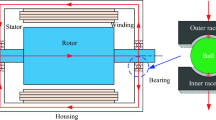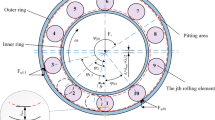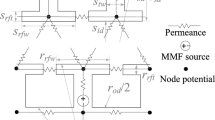Abstract
The gear transmission system has the advantages of high transmission efficiency and compact structure, and is widely used in a variety of mechanical equipment. However, due to the harsh working environment, key components such as gear pairs are prone to failure, which seriously affects the safety and stability of mechanical equipment. Therefore, it is very necessary to carry out modeling research on typical fault models of gear transmission system components, and to explore its fault mechanism and vibration characteristics. Most of the existing models model gear trains under normal conditions. Although some models have established failure models, they only consider the failure model of a single pair of meshing gears. Aiming at the above shortcomings, this paper establishes the fault model of single-stage fixed shaft gear system based on the dynamic model of single-stage fixed shaft gear system and combined with the energy method. The single-stage gear system’s dynamic response when a single gear is normal, cracked and peeled is solved and analyzed, and their spectrum characteristics are analyzed. It provides a theoretical basis for the health monitoring and fault diagnosis of the gear system.
Zusammenfassung
Das Zahnradgetriebesystem hat die Vorteile eines hohen Getriebewirkungsgrads und einer kompakten Struktur und wird häufig in einer Vielzahl von mechanischen Geräten verwendet. Aufgrund der rauen Arbeitsumgebung sind jedoch Schlüsselkomponenten wie Zahnradpaare anfällig für Ausfälle, was die Sicherheit und Stabilität der mechanischen Ausrüstung stark beeinträchtigt. Daher ist es sehr notwendig, Modellierungsforschung an typischen Fehlermodellen von Getriebesystemkomponenten durchzuführen und deren Fehlermechanismus und Schwingungseigenschaften zu untersuchen. Die meisten der vorhandenen Modelle modellieren Getriebezüge unter normalen Bedingungen. Obwohl einige Modelle etablierte Fehlermodelle haben, berücksichtigen sie nur das Fehlermodell eines einzelnen Paars kämmender Zahnräder. Mit dem Ziel, die oben genannten Mängel zu beseitigen, erstellt dieser Beitrag das Fehlermodell des einstufigen Festwellengetriebes basierend auf dem dynamischen Modell des einstufigen Festwellengetriebes und kombiniert mit der Energiemethode. Die dynamische Reaktion des einstufigen Getriebesystems, wenn ein einzelnes Zahnrad normal, rissig und abgeblättert ist, wird gelöst und analysiert, und ihre Spektrumseigenschaften werden analysiert. Es bietet eine theoretische Grundlage für die Zustandsüberwachung und Fehlerdiagnose des Getriebesystems.



















Similar content being viewed by others
References
Kohler HK, Pratt A, Thompson AM (1969) Paper 14: Dynamics and Noise of Parallel-Axis Gearing. SAGE Publications
Benton AS (1981) Factors influencing instability and resonances in geared systems. J Mech Des 103:372–378
Shiau TN, Lee EK, Young TH et al (2007) Dynamic Analysis of a Geared Rotor-Bearing System With Viscoelastic Supports Under the Bow Effect. In: ASME Turbo Expo 2007: Power for Land, Sea, and Air
Parey A, El Badaoui M, Guilletb F, Tandon N (2006) Dynamic modelling of spur gear pair and application of empirical mode decomposition-based statistical analysis for early detection of localized tooth defect. J Sound Vib 294:547–561
Saxena A, Parey A, Chouksey M (2016) Time varying mesh stiffness calculation of spur gear pair considering sliding friction and spalling defects. Eng Fail Anal 70:200–211
Tian X (2004) Dynamic simulation for system response of gearbox including localized gear faults. Master’s Thesis. University of Alberta, Edmonton, Alberta, Canada
Liang X, Zuo MJ, Pandey M (2014) Analytically evaluating the influence of crack on the mesh stiffness of a planetary gear set. Mech Mach Theory 76:20–38
Sainsot P, Velex P, Duverger O (2004) Contribution of gear body to tooth deflections—a new bidimensional analytical formula. Mech Des 126(4):748–752
Yang D, Sun Z (1985) A rotary model for spur gear dynamics[J]. Journal of Xi’an University of Technology
Zhao Z (2020) Research on vibration characteristics of typical faults in gear transmission system. Lanzhou University of Technology, Lanzhou
Lei Y (2016) Study on the new dynamic model of planetary gear train and its fault response characteristics. Chin J Mech Eng 52(13):114
Zheng H (2020) Dynamic modeling of gear spalling and fault diagnosis method of intelligent bearing signal. Chongqing University, Chongqing
Funding
By China Postdoctoral Science Foundation (No. 2020M680368), Natural Science Foundation of Chongqing, China (No. cstc2020jcyj-msxmX1081), VTDP.
Author information
Authors and Affiliations
Corresponding author
Ethics declarations
Conflict of interest
Wenjin Bei, Hui Liu, Pu Gao and Changle Xiang declare that they have no competing interests.
Additional information
Availability of data and material(data transparency)
Available
Code availability(software application or custom code)
Not applicable.
Appendix
Appendix
Notation | |
|---|---|
\(k_{h}\) | Hertz contact stiffness |
\(k_{b}\) | Bending stiffness |
\(k_{s}\) | Shear stiffness |
\(k_{a}\) | Radial compression deformation stiffness |
\(E\) | Elastic modulus |
\(L\) | Gear tooth width |
\(\nu\) | Poisson’s ratio of the gear material |
\(\alpha _{1}\) | The meshing pressure angle of the gear system |
\(\alpha _{2}\) | The half-tooth radian of the gear teeth on the base circle |
\(k_{f}\) | The rigidity corresponding to the flexible deformation of the gear base |
\(S_{f}\) | The tooth thickness at the root circle |
\(u_{f}\) | The shortest distance from the intersection of the gear meshing line and the gear axis of symmetry to the base circle |
\(I_{x}\) | The moment of inertia |
\(A_{x}\) | Effective area of the gear tooth section |
\(h_{c}\) | The vertical distance from the crack tip to the tooth centerline |
\(g_{c}\) | The horizontal distance from the crack tip to the tooth profile curve |
\(k_{\text{bcrack}}\) | Bending stiffness of cracked gear |
\(k_{\text{scrack}}\) | Shear stiffness of cracked gear |
\(k_{\text{bpeel}}\) | Bending stiffness of the peeled gear |
\(k_{\text{speel}}\) | Shear stiffness of the peeled gear |
\(k_{\text{aspeel}}\) | Radial compression stiffness of the peeled gear |
\(\alpha _{s1}\) | The angle corresponding to the peeling start position |
\(\alpha _{s2}\) | The angle corresponding to the peeling end position |
\(h_{sx}\) | The distance from a point on the peeling position to the center line of the tooth |
Rights and permissions
About this article
Cite this article
Bei, W., Liu, H., Gao, P. et al. Gear typical fault modeling and fault signal characteristics analysis. Forsch Ingenieurwes 86, 735–750 (2022). https://doi.org/10.1007/s10010-021-00555-x
Received:
Accepted:
Published:
Issue Date:
DOI: https://doi.org/10.1007/s10010-021-00555-x




